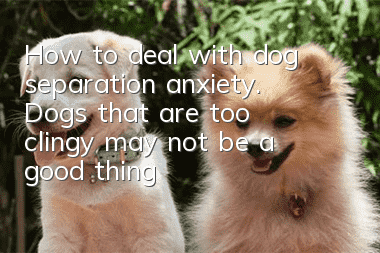How to deal with dog separation anxiety. Dogs that are too clingy may not be a good thing

What is separation anxiety
Most dogs enjoy the pleasure of chewing when they are alone at home and causing havoc; however, some will develop real anxiety Symptom - separation dysphoria. The main symptoms of separation dysphoria are: anxiety before the owner leaves (shortness of breath, pacing, drooling, shaking, depression and hiding in corners), not eating when alone at home, often when the owner is about to leave. Just started not eating.
Separation dysphoria usually begins after a triggering event. For example, when you move to a new home or your life routine undergoes major changes.
How to deal with separation anxiety
1. Leave your dog alone for a short period of time
Keep the first time away short, preferably within five minutes. After the dog's reaction is not too strong, start to gradually stretch for a long time, such as 15 minutes, half an hour, 1 hour, 2 hours, etc. This separation exercise should be performed frequently in the first few days when the dog comes home.
Practice "internal separation" first. Just put the dog in a room, then the owner leaves the room and closes the door. Let the dog get used to the fact that even if the owner is at home, he will not be with him all the time.
Then practice "external separation." Keep the dog in a room and the owner leaves the house. After such separation training, the dog can know that the owner will not always be around, and that the owner will always come back after leaving.
2. Don’t say hello to your dog every time you leave
The owner's reluctant tone and expression will make the dog anxious about the upcoming solitude.
3. Don’t appear in front of the dog when it is whining. Wait for it to stop before entering.
If the owner comes back when the dog is whining, the dog will bark harder and harder in the future.
4. Let all "good things" happen when the owner leaves and comes back
After the owner leaves, it is best to arrange food, games and walks, so that the dog will form a conditioned reflex: "Mom leaves = good things are coming."
- Is it better for Dogo dogs to have their ears erect or cropped? A case of Dogo dog’s ear erection surgery will tell you
- What do dogs eat to protect their stomach? It is important to protect their stomach and treat gastrointestinal diseases in dogs.
- How to tell if your dog is fat? Is your dog overweight?
- Will your dog catch a cold if you blow the air conditioner? What should you do if your dog catches a cold if you blow the air conditioner?
- What should you pay attention to when your dog drinks water? Don’t be careless when it comes to your dog’s drinking water.
- The dog's mouth bites and shakes. Why does the dog's mouth occasionally shake and bite?
- How to cut a dog's hair? Do you know how to cut a dog's hair correctly?
- Can dogs eat raw eggs? Why can’t dogs eat egg whites?
- Common Dog Problems in Summer How to Deal with Different Dog Problems
- How to keep dogs away from skin diseases. If you do this, will you see if your dog will still be infected with skin diseases?



